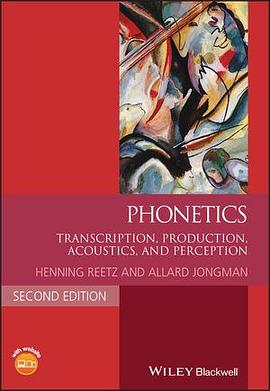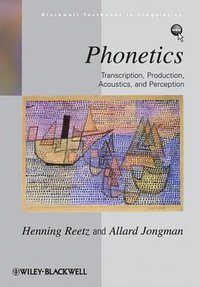Phonetics
豆瓣
Transcription, Production, Acoustics, and Perception, 2nd edition
Henning Reetz / Allard Jongman
简介
An accessible yet in-depth introductory textbook on the basic concepts of phonetics, fully updated and revised
This broad, interdisciplinary textbook investigates how speech can be written down, how speech is produced, its acoustic characteristics, and how listeners perceive speech. Phonetics: Transcription, Production, Acoustics, and Perception introduces readers to the fundamental concepts of the discipline, providing coverage of all four areas of phonetics. This comprehensive textbook also familiarizes readers with concepts from other disciplines related to phonetics—such as physiology, anatomy, and psychology—through relatable, real-life examples.
Now in its second edition, the text has been substantially revised to improve clarity and currency, based on student feedback received by the authors over the past decade. Brief “Nutshell” introductions have been added to all chapters to provide a clear overview of key points within the body of the text. Expanded content to this new edition examines voice quality, the acoustic correlates of different phonation types, intonation, and different theories of speech perception. Written in a clear and concise style by two of the field’s leading scholars, this textbook:
· Covers related relevant areas, including vocal fold vibration and the physiology of the ear
· Offers examples from other languages to highlight aspects of phonetics not found in English
·Includes chapter-by-chapter exercises, engaging illustrations, and a detailed glossary
·Features a companion website containing additional resources such as figures and sound files
Phonetics: Transcription, Production, Acoustics, and Perception, 2nd Edition is an ideal text for both introductory and advanced courses in phonetics and speech science, general linguistics, related disciplines such as psychology, speech pathology, and audiology, and for anyone interested to learn about how we speak and hear.
contents
Preface to the First Edition
Preface to the Second Edition
About the Companion Website
1 About this Book
1.1 Phonetics in a nutshell
1.2 The structure of this book
1.3 Terminology
1.4 Demonstrations and exercises
2 Articulatory Phonetics
Articulation in a nutshell
2.1 Phonation at the larynx
2.2 Basic articulatory terms
2.3 The articulation of consonants
2.3.1 Place of articulation
2.3.2 Manner of articulation
2.3.3 Other classification schemes
2.4 The articulation of vowels
3 Phonetic Transcription
Transcription in a nutshell
3.1 Types of transcription
3.2 Consonants
3.2.1 Plosives
3.2.2 Nasals
3.2.3 Fricatives
3.2.4 Affricates
3.2.5 Approximants
3.3 Vowels
3.4 Diacritics and other symbols
3.5 Transcription of General American English
3.5.1 Consonants
3.5.1.1 Aspiration, voicing, and devoicing
3.5.1.2 Coarticulation
3.5.1.3 Consonantal release
3.5.1.4 Flaps and taps
3.5.1.5 Glottal plosives
3.5.1.6 Velarization
3.5.1.7 Syllabic consonants
3.5.1.8 Intrusion
3.5.1.9 Duration
3.5.2 Vowels
3.5.2.1 Duration
3.5.2.2 Effects of following consonants
4 Place and Manner of Articulation of Consonants and Vowels
4.1 Consonants
4.1.1 Labials
4.1.2 Coronals
4.1.3 Dorsals
4.1.4 Gutturals
4.2 Additional manners of articulation
4.3 Vowels
4.4 Secondary articulations
5 Physiology of the Vocal Apparatus
Physiology in a nutshell
5.1 The subglottal system: lungs, bronchi, and trachea
5.1.1 Anatomy of the subglottal system
5.1.2 Movements of the lungs
5.1.2.1 Breathing in (inspiration, inhalation)
5.1.2.2 Breathing out (expiration, exhalation)
5.1.3 The volumes of the lungs and their control over time
5.1.4 Loudness and the air pressure in the lungs
5.2 Structure and function of the larynx
5.2.1 Anatomy of the larynx
5.2.2 Vocal fold vibration
5.2.2.1 The Bernoulli effect and the aerodynamic theory
5.2.2.2 The myoelastic theory of vocal fold vibration
5.2.2.3 Two‐mass theory of vocal fold vibration
5.2.2.4 Muco‐viscose, cover body, and flow‐separation theory
5.2.2.5 One cycle of vocal fold vibration
5.2.3 Loudness and larynx signal
5.2.4 Register
5.3 Vocal tract
5.3.1 Pharynx
5.3.2 Nasal tract and velum
5.3.3 Oral tract
6 Airstream Mechanisms and Phonation Types
Airstream mechanisms and phonation in a nutshell
6.1 Airstream mechanisms
6.1.1 Glottalic airstream mechanisms
6.1.2 Velaric airstream mechanism
6.2 Phonation types
6.3 Voicing, voicelessness, and aspiration in plosives
6.4 Common and rare sounds
7 Basic Acoustics
Basic acoustics in a nutshell
7.1 Sound waves
7.1.1 Sound waves are variations in air pressure
7.1.2 Origin and propagation of sound waves
7.1.3 The speed of sound
7.1.4 Relative positions within a sound wave
7.1.5 Longitudinal waves and transverse waves
7.2 Measuring sound waves
7.2.1 The microphone
7.2.2 The oscillogram or waveform
7.3 Acoustic dimensions and their units of measurement
7.3.1 Frequency
7.3.1.1 Period duration
7.3.1.2 Period duration and period frequency
7.3.1.3 Period frequency and wavelength
7.3.1.4 Representing F0 over time
7.3.2 Amplitude
7.3.2.1 Representing amplitude changes over time
7.3.3 Phase
8 Analysis Methods for Speech Sounds
Analysis in a nutshell
8.1 Digitizing acoustic signals
8.1.1 Digitizing in the time and amplitude domains
8.1.2 Sampling rate
8.1.3 Quantizing resolution
8.2 Types of acoustic signals
8.3 Analyzing acoustic signals
8.3.1 Fourier transformation
8.3.1.1 Summing up signals: Fourier synthesis
8.3.1.2 Decomposing signals: Fourier analysis
8.3.1.3 Harmonic frequencies
8.3.1.4 Discrete Fourier transformation and “fast Fourier transformation”
8.3.1.5 Fourier transformation for non‐periodic signals
8.3.2 What information can be seen in a spectrum?
8.3.3 “Windowing” in spectral analysis
8.3.3.1 The relation between window size and spectral resolution
8.3.3.2 The relation between resolution in the time and frequency domains
8.3.4 Other spectral representations: the spectrogram
8.3.5 The LPC spectrum
8.3.6 The cepstrum and cepstrally smoothed spectrum
9 The Source–Filter Theory of Speech Production
The source–filter theory in a nutshell
9.1 Resonance
9.1.1 Resonating frequencies of cylindrical tubes
9.1.2 Resonating frequencies of non‐cylindrical tubes
9.2 Damping
9.3 Filters
9.3.1 Vocal tract filter
9.3.2 Radiation at the lips and nostrils
9.4 Formants
9.4.1 Formant frequencies
9.4.2 Formant bandwidth and quality
9.5 Sources for speech sounds
9.5.1 The glottal source: phonation for a modal voice
9.5.1.1 Jitter
9.5.1.2 Shimmer
9.5.1.3 Harmonics‐to‐noise ratio (HNR)
9.5.1.4 H1‐H2 measure and spectral tilt
9.5.2 Breathy voice
9.5.3 Creaky voice
9.5.4 The noise source: turbulence
9.5.4.1 Whisper
10 Acoustic Characteristics of Speech Sounds
Acoustic characteristics in a nutshell
10.1 Vowels
10.2 Consonants
10.2.1 (Central) approximants
10.2.2 Fricatives
10.2.3 Plosives
10.2.4 Nasals
10.2.5 Lateral approximants
10.2.6 Affricates
10.3 Summary
10.4 Variability and invariance
10.4.1 A theory of acoustic invariance
11 Syllables and Suprasegmentals
Syllables and suprasegmentals in a nutshell
11.1 Syllables
11.2 Stress
11.3 Length
11.4 Tone and intonation
11.4.1 Tone
11.4.2 Intonation
12 Physiology and Psychophysics of Hearing
Hearing in a nutshell
12.1 The external ear
12.2 The middle ear
12.2.1 Increase in pressure in the middle ear
12.2.2 Sound attenuation in the middle ear
12.2.3 Pressure equalization in the tympanic cavity
12.2.4 The oval window
12.3 The internal ear
12.3.1 Pressure waves in the cochlea
12.3.2 The basilar membrane as an oscillating body
12.3.3 Resonance theory
12.3.4 Objections to the resonance theory
12.3.5 Traveling wave theory
12.4 The structure of the basilar membrane
12.4.1 Outer hair cells
12.4.2 Inner hair cells
12.4.3 Frequency coding along the basilar membran
12.4.4 Oto‐acoustic emissions
12.5 Auditory frequency scales
12.5.1 Linear scales
12.5.2 Logarithmic scales
12.5.3 Mel scale
12.5.4 Bark scale
12.5.5 Equivalent rectangular bandwidth (ERB) scale
12.6 Auditory loudness scales
12.7 Auditory time scales
13 Speech Perception
Speech perception in a nutshell
13.1 Vowels
13.1.1 Extrinsic versus intrinsic normalization
13.2 Consonants
13.2.1 Approximants
13.2.2 Fricatives
13.2.3 Nasals
13.2.4 Plosives
13.3 Contributions of the motor theory of speech perception
13.3.1 Categorical perception
13.3.2 Is speech “special”?
13.3.2.1 Non‐speech perception
13.3.2.2 Animal perception
13.4 Theories of speech perception
13.5 The role of linguistic experience in speech perception
13.6 Summary
Appendices
A.1 Mass, Force, and Pressure
A.2 Energy, Power, and Intensity
A.3 The Decibel (dB)
A.3.1 RMS amplitude
A.3.2 RMS amplitude and loudness
A.3.3 Calculations with dB values
B.1 Physical Terminology
B.2 Mathematical Notations
C.1 Formant Values
C.2 Fundamental Frequency Values
D.1 Glossary
References
Index

